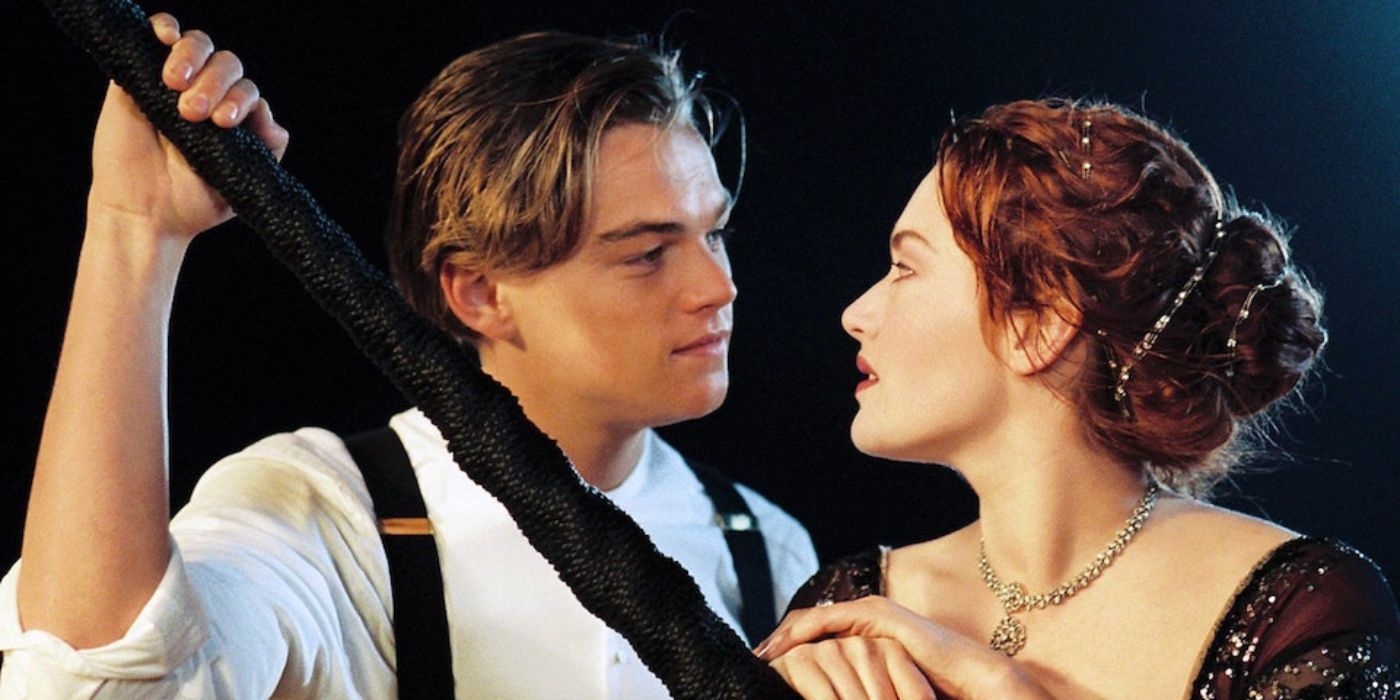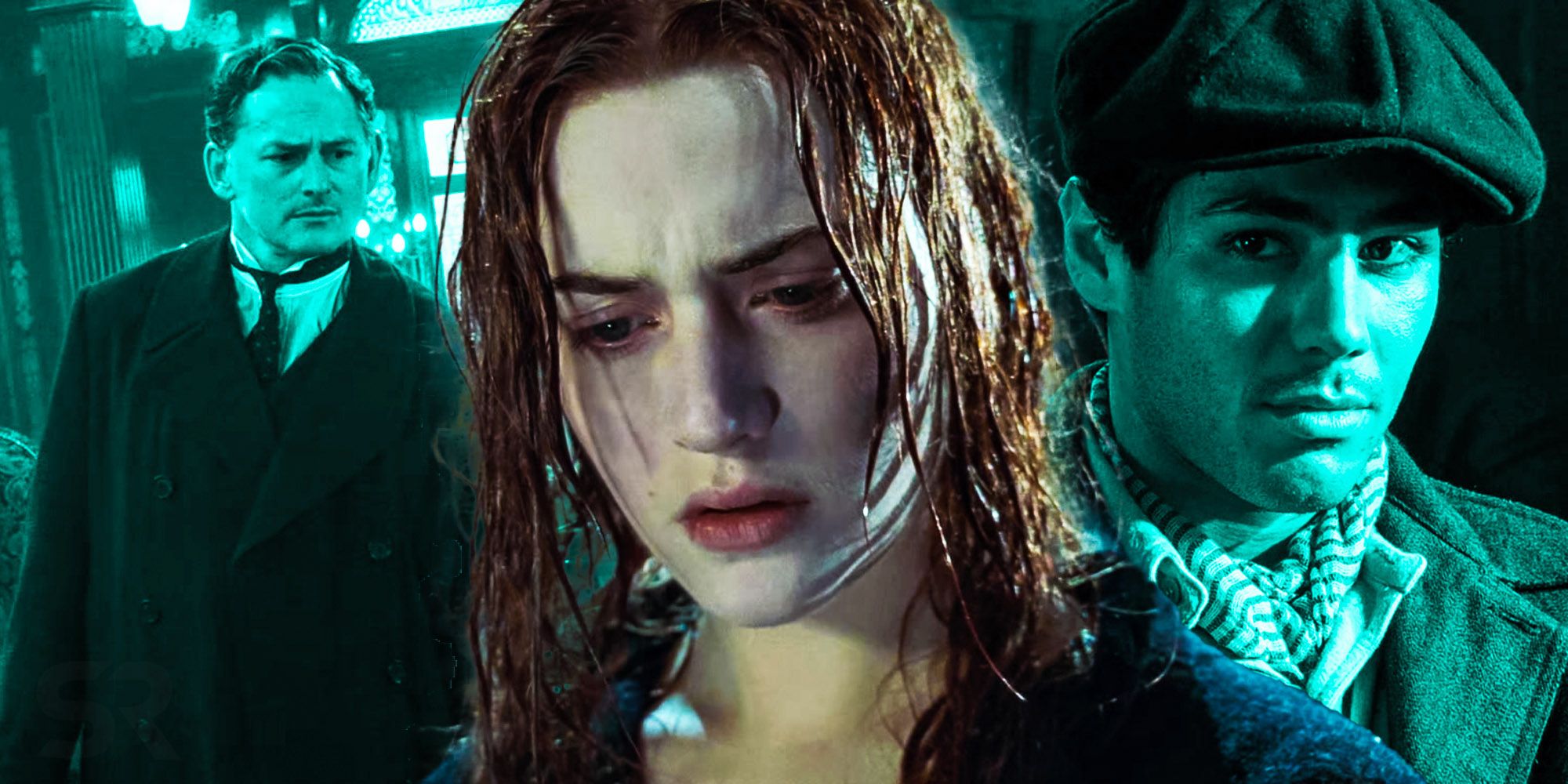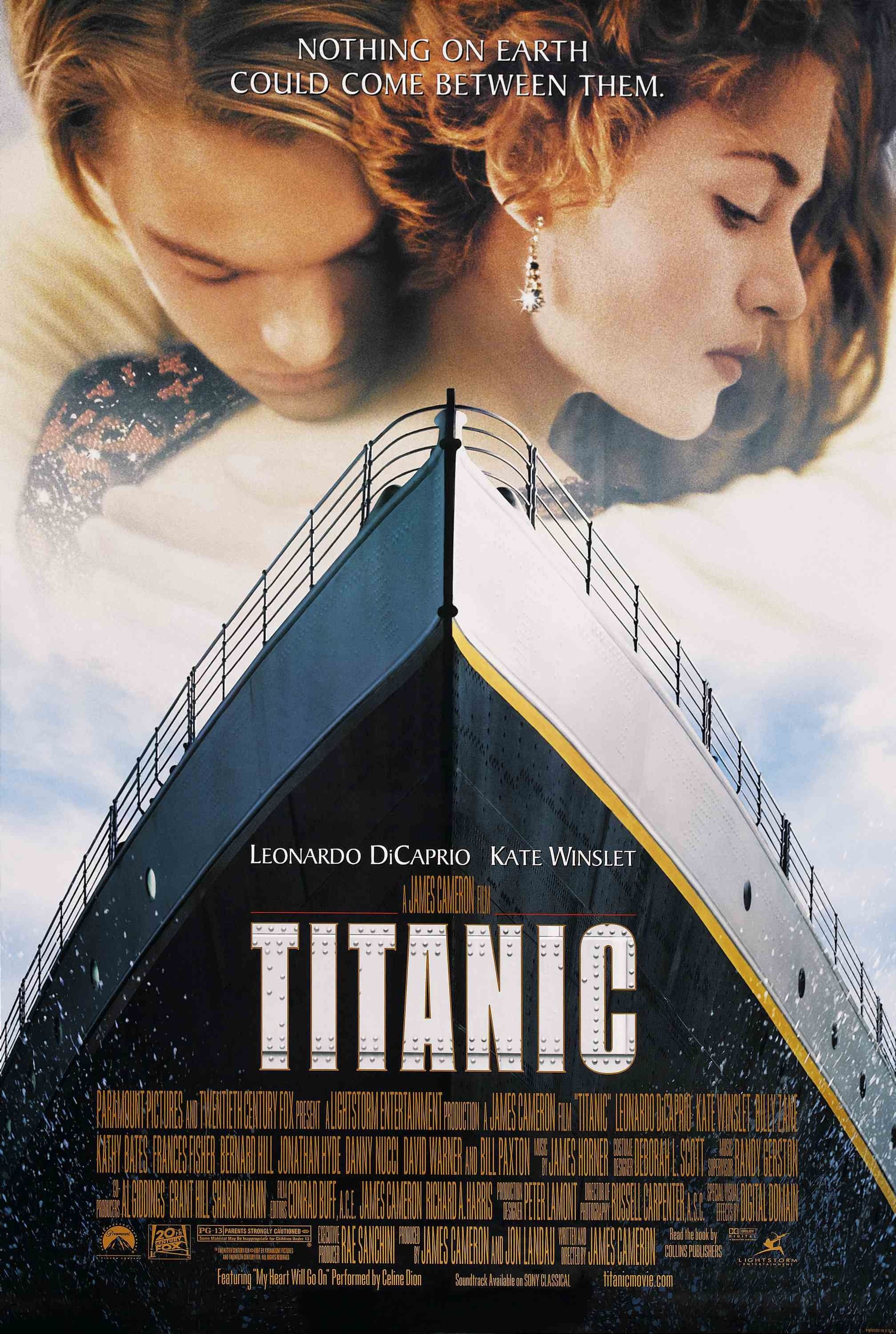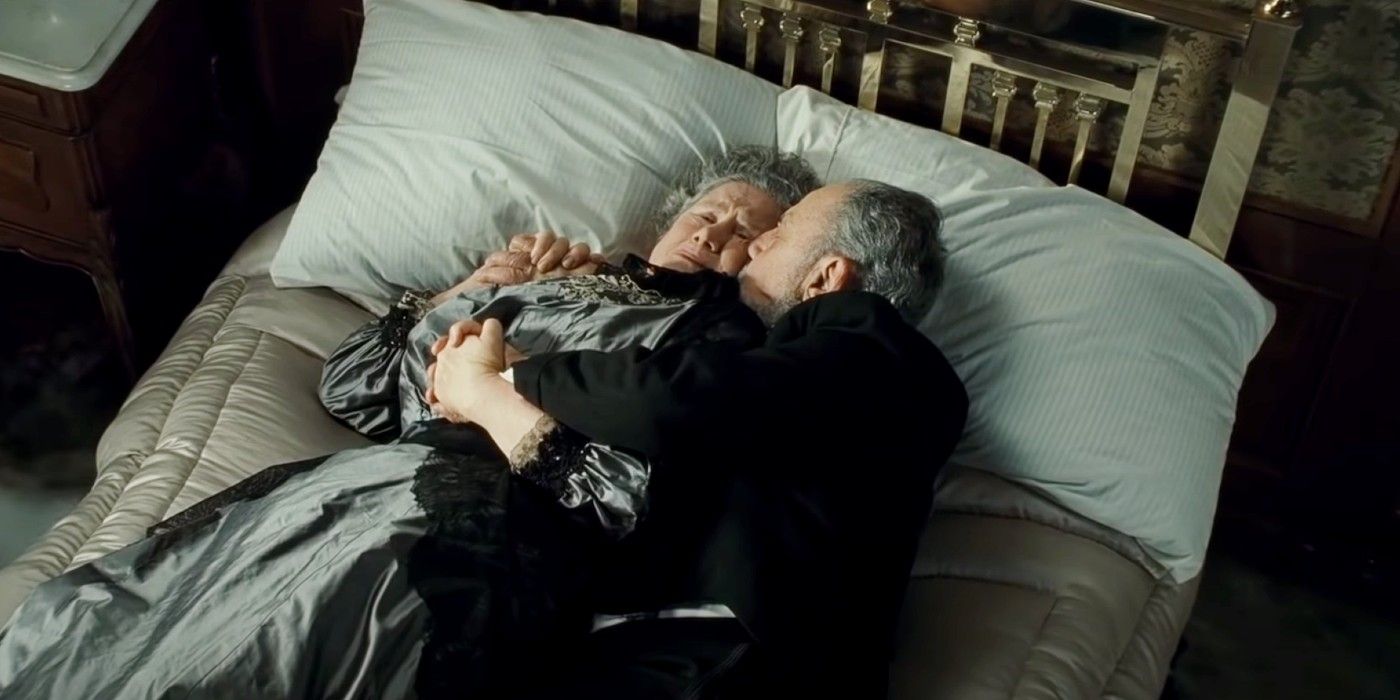Summary
- Titanic’s success was praised for visuals and performances, though some criticize the love story.
- Beatrice Wood inspired Rose’s character, but Jack’s character is unrelated to a real person.
- James Cameron combined real-life elements with fictional touches to tell the Titanic story.
The Titanic real story adaptation made for one of the most impressive cinematic achievements that viewers constantly revisit. James Cameron became a widely known and respected name in the film industry thanks to The Terminator franchise, but he drew a lot more attention in 1997 with Titanic, a romance-disaster movie based on the accounts of the sinking of the RMS Titanic in 1912. It was his most ambitious project up to that point. Titanic tells the story of Rose DeWitt Bukater (Kate Winslet) and Jack Dawson (Leonardo DiCaprio), two passengers from different social classes who fall in love.
Titanic was a big success with both critics and viewers, becoming the highest-grossing movie ever at the time. It was praised for its visuals and performances, though some criticized Rose and Jack’s love story. Still, Titanic has a special place in the hearts of many and continues to be one of Cameron’s best works. Although Titanic is ultimately based on a true story and even added some real-life characters, not everything in the movie actually happened. James Cameron had to either change, add, or embellish some details to fit the story he wanted to tell.

Related
The 60 Best Movies Of All Time
Screen Rant breaks down the best movies of all time, from old classics to modern masterpieces across multiple genres of cinema.
The Real-Life Inspiration Behind Rose
How Beatrice Wood Shaped Rose
The real story of Titanic did not include the exact characters of Jack Dawson and Rose DeWitt but there was some truth behind the characters. They were inspired, to an extent, by some real-life people, though Rose’s inspiration has no connection to the actual Titanic.
As revealed by Cameron, artist Beatrice Wood was the inspiration behind Rose.
As revealed by Cameron, artist Beatrice Wood was the inspiration behind Rose. Cameron read her autobiography during Titanic’s development. Wood was a painter, sculptor, writer, and actress from a family of wealthy socialites. As he was reading Wood’s book, Cameron said that he realized it described “almost literally” the character of “Old Rose.” The movie’s Rose is “only a refraction of Beatrice, combined with many fictional elements.” There is no Rose in Titanic‘s true story.
“Wood and Rose could both be described as progressive characters. Beatrice Wood’s art was controversial and shocking for her era, and even in her later years, Wood was personified as a rebellious spirit, mirroring how Rose grew out from under the shadow of a conservative upbringing and became a more independent person.” –
Read more on Beatrice Wood in Screen Rant’s ”
What Happened To Titanic’s Real Rose, Beatric Wood?
“
As for Titanic‘s Jack, he wasn’t inspired by anyone, but his name is similar to that of a man who was on board the Titanic. A man who signed as “J. Dawson” was on the Titanic, but the “J” stood for Joseph, and he was born in Dublin. He was part of the ship’s crew, working as a coal trimmer.
Cameron didn’t know a real-life Joseph Dawson existed until the script was finished, so the two Dawsons were a coincidence. Joseph Dawson’s grave received many visitors after Titanic was released. They left cinema stubs and pictures of Leonardo DiCaprio as they believed it was the resting place of Jack Dawson.
The Real Molly Brown
A Voice For The Voiceless
Kathy Bates’ unforgettable character, Molly Brown, was one of the few relevant characters in Titanic based on real-life people who were actually on board. Margaret Brown was an American socialite and philanthropist but wasn’t born into a wealthy family. Margaret married James Joseph “J.J.” Brown, who wasn’t a rich man either.
Still, the family acquired great wealth when his mining engineering efforts turned out to be instrumental in producing a substantial ore seam. Margaret and Brown separated in 1909 but continued to care for each other. The agreement gave her a cash settlement and monthly allowance that made it possible to continue her travels and social work.
When the real Titanic hit the iceberg and began to sink, Margaret helped other passengers board lifeboats and had to be persuaded to leave the ship (in Lifeboat No. 6). Once there, she urged that the lifeboat go back to save more people, but the crewman opposed it. Margaret threatened to throw the crewman overboard, and sources vary whether they returned and if they found anyone alive. Molly’s role in Titanic history only grew after the disaster
Once aboard the RMS Carpathia, the ship that rescued the Titanic survivors, Margaret coordinated with other first-class passengers to help survivors from the lower classes. Not only that, but the woman named “Unsinkable Molly Brown” by the media” also went on to set up a survivor’s committee, arranging burials for those lost when their bodies were recovered. According to Titanic Historical Society Don Lynch, she was ultimately robbed of the ability to put her account on record when the time came:
“
She was also vehemently upset that she was not able to testify at the Titanic hearings, at the inquest, because she was a woman.”
Margaret Brown passed away in 1932 at 65.

Related
Titanic Cast & Character Guide
James Cameron’s 1997 blockbuster includes a stellar cast playing some timeless fictional characters and a few real-life historical personalities.
The Titanic Really Hit An Iceberg
The Reality Of The Disaster That Shocked The World
The sinking of the Titanic after hitting an iceberg is unequivocally a true story. April 14, 1912, at 11:40 p.m. (ship’s time), the crew spotted an iceberg and alerted the bridge. First Officer Willaim Murdoch ordered the ship to be steered around the iceberg and the engines to be stopped, but there wasn’t enough time.
The ship’s starboard side hit the iceberg. The hit created a series of holes below the waterline, and though the hull was not punctured, it was dented and allowed water to seep in. According to survivors, as depicted in the movie, pieces of the iceberg landed on the promenade deck.
Titanic only had enough lifeboats to carry half the passengers.
Titanic‘s real crew was not prepared for an emergency of this magnitude. As ships were seen as unsinkable then, the Titanic only had enough lifeboats to carry half the passengers. The crew didn’t know how to properly carry out an evacuation and launched many lifeboats half-full, with third-class passengers left behind, causing many of them to become trapped below decks as the ship filled with water.
A little over two and a half hours after the Titanic hit the iceberg, the deck dipped underwater, and water poured in through open hatches and grates. As its unsupported stern rose, the ship broke into two pieces. The real Titanic sank at 2:20 a.m. Most of the remaining passengers and crew were immersed in freezing water, dying within 15 to 30 minutes. As seen in the movie, the lights continued to burn until just before the ship went under, and as recalled by a survivor, a series of “terrific explosions occurred,” probably from the boilers.
The wreckage of the Titanic was found on September 1, 1985, during an expedition led by Jean-Louis Michel and Robert Ballard, who discovered that the ship had, in fact, split apart. It was long believed it sunk in one piece. Titanic covered the ship’s sinking in a way that was very true to life.
The Band Continued Playing
The Music Never Stopped
One of the most memorable moments from the Titanic‘s true story made it into the movie as the string quartet played as the ship began to sink. In real life, the Titanic’s band did continue to play, but it’s unclear which was the last song they played. Survivors reported the band played “Alexander’s Ragtime Band” and “In The Shadows,” and newspapers shared the final song was “Nearer, My God, To Thee,” while survivors said it was “Song d’Automne.” Cameron’s movie chose to go with the somber “Nearer, My God, To Thee”.

Related
Every Character That Appears In Titanic Heaven (And The One That’s Missing)
At the end of Titanic, Rose joins Jack at the ship’s Grand Staircase in her version of heaven, and here’s every character spotted in that scene.
The Elderly Couple
A Final Embrace
An unforgettable and heartbreaking moment in Titanic sees an elderly, first-class couple who stayed on the ship and embraced in bed as their room filled with water. This was also based on fact as the couple was Macy’s owner Isidor Straus and his wife Ida. They were offered a place on Lifeboat No. 8, but Isidor chose to stay on board as long as there were women on board. Ida refused to leave her husband.
According to witnesses, Ida told him, “we have lived together for many years. Where you go, I go.” They were last seen sitting on deck, which witnesses described as a “most remarkable exhibition of love and devotion.” Only Isidor’s body was recovered and more of their story was seen in the Titanic deleted scenes.
Passengers Were Rescued From The Water
Lifeboats 4 & 14: The Only Boats to Return In The Titanic Disaster
As seen in Titanic, the true story of two of the 16 lifeboats returned to pick up survivors from the water, but the shock and more were too much for some, and they died on the boats. The boats that returned were Lifeboat 4, led by Quartermaster Perkis, who reportedly pulled five people from the water (of which only three survived), and Lifeboat 14, headed by Fifth Officer Harold Lowe (played by Ioan Gruffud in Titanic), who with the help of a working crew of six men, picked up four people from the water.
The Carpathia Rescued The Survivors
The Story Of The Rescue Of The Titanic Survivors
At around 4:00 a.m. on April 15, the real Titanic’s survivors were rescued by the Carpathia, and the bodies of those who died on the lifeboats overnight were left on the boats and recovered sometime later. Carpathia was bound for Fiume, Austria-Hungary (now Rijeka, Croatia). Still, as it had neither the stores nor medical facilities to look after the Titanic survivors, it changed its course and returned to New York so that the survivors could be properly looked after.
Many of the Titanic survivors lived for many more years, while others succumbed to shock and other problems and died weeks after the disaster. After the disaster, Margaret Brown presented an award to the captain of the Carpathia for his role in saving the survivors.
Was There Space For Jack On The Door?
A Titanic-Sized Debate
Titanic’s true story found many of the passengers that went into the water attempting to stay afloat on whatever they could find, which is what Jack and Rose attempted to do as well. The infamous door scene is definitely one of the saddest in Titanic, and in turn, raised a lot of questions. The most famous and hotly debated aspect of the movie is whether Jack could have fit on the door with Rose. Based on the size of the makeshift raft, Jack could’ve gotten on without the door sinking. However, it is more complicated than that.
The real question is whether either of them could have still survived if they were.
The longer answer, however, is more complicated than simply whether Jack and Rose could both fit on the door. The real question is whether either of them could still have survived if they were. An episode of Mythbusters recreated the scene in order to test the theory that Jack could have survived, and while the series found he could, further experimentation was done with James Cameron himself supervising.
Cameron has been asked repeatedly in interviews as to why Rose and Jack didn’t share the door, and he decided to find an answer to the question 25 years after the movie hit theaters. In The National Geographic special Titanic: 25 Years Later With James Cameron, scientists and Cameron worked out multiple scenarios involving Jack, Rose, the door, and the freezing ocean waters.
While the experiments demonstrated that both of them could have been on the door, they also demonstrated that their vital organs had to be above the water line to prevent them from succumbing to hypothermia or shock. The conclusion was that Jack and Rose, if both on the door, might have survived the 30 minutes together for a lifeboat to get there, but other variables in play could have changed the outcome at any time.
Cameron also pointed out in the special that what really matters is that Jack wanted to guarantee Rose’s survival. His decision not to hop up on the door with her is to make sure she was out of the water and able to rest after a strenuous fight to survive the sinking Titanic. Cameron said, “I think his thought process was, ‘I’m not going to do one thing to jeopardize her,’ and that’s 100 percent in character.”
Despite whether Jack could’ve lived in real life, Cameron stuck adamantly to his choice for years, wishing that the whole debate would go away. In an interview, Cameron told BBC Radio 1:
“[…] could Romeo have been smart and not taken the poison? Yes. Could he have decided not to bring his little dagger just in case Juliet might stab herself with it? Yes, absolutely. It sort of misses the point.”
It may miss the point of Titanic, but it doesn’t stop the theory that Jack could’ve lived if Rose had just moved over a little – and that James Cameron killed Jack as deliberately as the icy Atlantic.
James Cameron Did His Titanic Research
From Script To Screen!
Regardless of how much James Cameron stuck to the Titanic‘s real story, it cannot be denied that the filmmaker went to great lengths to make the movie as authentic as possible. One of the early ideas Cameron had (via GQ) was to build an actually floatable replica of the ship to use for filming. While Cameron didn’t balk at the $10 million cost of making it, he decided against it when he realized he could only get one take of the sinking of the ship.
In writing the screenplay for the movie, Cameron put the so-called “Romeo and Juliet on the Titanic” story at the center but wanted to pay tribute to the crew of the ship and the people who actually lost their lives in the wreck. Cameron also put together a detailed timeline of the events to recreate the sinking as accurately as possible. He consulted historical experts to gain an understanding of how the events would have realistically unfolded from the time the ship struck the iceberg to when it finally sunk below the water’s surface.
Of course, it has been said the real reason Cameron made Titanic was for the opportunity to explore the shipwreck firsthand. Cameron convinced the studio to fund expeditions to film the real remains of the ship at the bottom of the ocean, taking several trips down there and even colliding the filmmaker’s submersible with the Titanic on one occasion. While the footage made for a breathtaking way to begin the movie, it also afforded Cameron an invaluable sense of responsibility for getting to story right in Titanic, as he explained (via CBC)
“you get such a strong sense of the profound sadness and injustice of it, and the message of it
.”
Titanic Always Had To Be Embellished
James Cameron’s Fictional Elements Strengthened The Factual Elements
There is no doubt that there were interesting elements and historical figures who could have played a bigger role in Titanic to make a truly accurate account of the event. However, James Cameron was smart enough to know that adding in some fictitious elements and embellishing certain facts made for a better movie. The most effective element in this regard is how Cameron created the characters of Jack and Rose.
Though there may be factual inspirations for these characters, making them largely fictional characters allowed Cameron to shape the story he wanted without being beholden to facts. For instance, Beatrice Wood’s story is a fascinating one, but it doesn’t make for the sweeping romance story Titanic needed to be a massive blockbuster. Instead, Rose shares elements of Wood’s life, but she is able to have her own story. Likewise, though there may be a grave with the name of a Titanic casualty named Jack Dawson, Cameron didn’t feel the need to tell his story verbatim.
Cameron let these fictional characters drive the central human story of Titanic, letting them be the audience vessels through which the audience could witness the events of the sinking. This allowed him to then focus on the facts of the sinking itself and how the tragedy unfolded. The mix of fact and fiction might draw some critics to eagerly point out the inaccuracies, but it was a wise move that helped make Titanic the massive blockbuster movie that it was.

Titanic
Titanic is the 1997 blockbuster romantic/disaster epic based on the events surrounding the sinking of the legendary “unsinkable” vessel. Flashing back to the past and forward to the present, the film primarily follows the stories of the well-to-do and somewhat timid Rose and the poor but lively Jack, star-crossed lovers who meet aboard the doomed ship. In addition, the film tells true and fictionalized accounts of the passengers of the RMS Titanic, with an older Rose recounting her tale to the crew of a research ship.
- Release Date
- December 19, 1997
- Runtime
- 3h 14m
